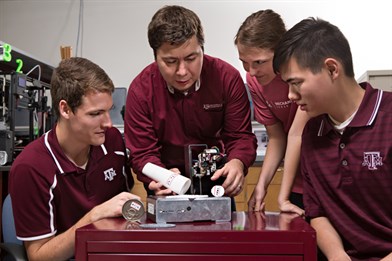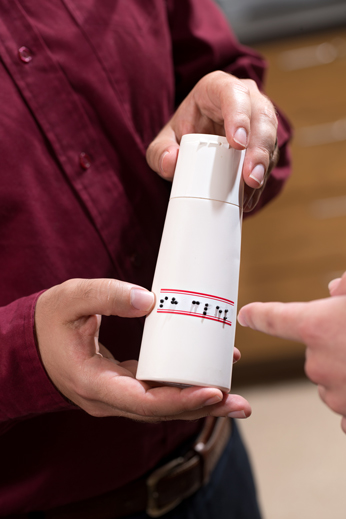 Researchers with the Department of Mechanical Engineering at Texas A&M University are making it easier for the visually impaired to read by manufacturing high quality adhesive labels through portable 3-D printers so that braille can be found on a variety of consumer products. The project, led by assistant professor of instruction Dr. Tanil Ozkan, is unique in not only the benefits it is providing for this specific population, but also in its high-impact instructional approach for undergraduate engineering students, giving them the ability to be actively engaged in research development and distribution.
Researchers with the Department of Mechanical Engineering at Texas A&M University are making it easier for the visually impaired to read by manufacturing high quality adhesive labels through portable 3-D printers so that braille can be found on a variety of consumer products. The project, led by assistant professor of instruction Dr. Tanil Ozkan, is unique in not only the benefits it is providing for this specific population, but also in its high-impact instructional approach for undergraduate engineering students, giving them the ability to be actively engaged in research development and distribution.
“The goal was to have my undergraduate students engaged in every step of the project,” Ozkan said. “With any kind of product development or innovation, it is always the case that when you start learning things and get more experience, you kind of become rigid in terms of what you can and cannot do. Young minds don't have these restrictions, and in many cases not knowing anything about the rules is exactly what you need for great innovation.”
The work Ozkan and his students are doing initially began with working to provide labels in braille directly on the packaging of everyday consumer products such as shampoo and eating utensils. According to Ozkan, due to the dynamics of the American consumer market, it has been difficult to get distributors to include braille labelling on their packaging. Additionally, the standard 3-D printing polymers used in applying the 3-D printed braille to the packaging is not reliable. To solve this problem, the team created durable adhesive labels to allow easy printing and adhesion to the packages.
“We've also had a former undergraduate and current graduate student here at Texas A&M, Yasushi Mizuno, develop a non-contact sensor technology which detects surface curvature and height differences on the plane of the labels so that optimal process parameters can be determined with the digitally generated surface within the software for the subsequent 3-D printing,” Ozkan said. “This allows the labels with the braille to fit the surface well.”
Ozkan and his students were able to develop a portable and compact type of 3-D printer that allows the labels to be printed easily. A major concern, according to Ozkan, was to ensure that the technical expertise needed to operate the machine was not beyond that of the everyday person, which is uncommon among 3-D printers that are commercially available.
“We have developed some software and written our own code that would basically create these braille characters and then place them, with the desired size font, on the label,” Ozkan said. “This still requires some level of technical expertise, so what we are thinking is that if we combine this technology with a portable 3-D printer, this can be taken to schools, nursing homes and public libraries where the blind and visually impaired members of our society have access to other services.”
In addition to their work in braille 3-D printing, Ozkan and his students are also working on a unique method that will allow all consumers, including the visually impaired, to read expiration dates on products by touch. The method involves using a color changing polymer which is encased in gel. The permeability of the polymer will change and dissolve over time, allowing the visually impaired to determine the shelf life of a product based on how firm the gel is. For common consumers, the severity of discoloration would be the indication of the remaining shelf life before a product’s expiration date. The next step in circulating products like this and the 3-D printed labels will involve Ozkan and his students working with regulatory bodies and organizations that handle braille standardization and consumer health to increase the awareness of these issues and make the technology available to those who need it.
“Texas A&M has a nice tradition of doing this kind of leading work for the good of society,” Ozkan said. “Our students seem to be very much aware and interested in these kinds of technologies which will assist all those who need it. I think it is very useful and helpful for the students to gain such an experience doing this because this process is essentially the same as what these students will have in their engineering careers in terms of product development, combining technologies and working together in a coordinated way in order to get the best outcome.”
Photo Caption: (top photo) The team working on 3D printing of braille labels (from left to right): Cullen Chovanec, Tanil Ozkan, Madeleine Horelica and Joshua Vandervort. (bottom photo) Example of a braille label on a shampoo bottle
Video: Highly durable and waterproof braille labels can be attached to any surface. For details of the process, please watch the video.